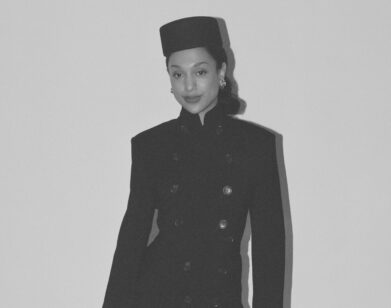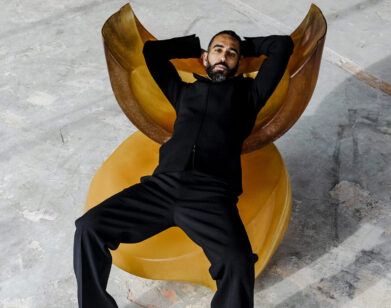Anicka Yi
Anicka Yi, Conceptual Artist at the Hair Salon, 2014: skin, teeth, iPhone, pearl rings, unpainted fingernails, black rubber sandals, black cotton barber cloth, hair, tin foil, bleach. Dimensions variable. The installation is only on view for two hours, or as long as it takes for the bleach to interact with Yi’s hair, changing black into blues that vary from parakeet to sky. “I wish you could synthetically replicate this [hair] color,” says Yi, holding still in a swivel chair in a shoebox hair salon in SoHo. “But it just … happened. I wanted to be blond, and somehow, for some chemical reason, my hair came out swirled with cerulean. If you ask my hairdresser, she’ll tell you that nothing like this has ever happened in all the years she’s been coloring hair.”
If the colorist is surprised, the cognoscenti who surround the Seoul-born, New York-based artist are not. Peculiar, pretty accidents and magical alchemies of the mundane are precisely Yi’s stock in trade, whether she is arranging deep-fried Q-tips (Ear Condom May Contain Traced Nuts, 2009) or vacuum-sealing peanuts and pearls into a tall plastic wall hanging (I’m Every Woman I Ever Met, 2011) or planting six snails injected with oxytocin—the “love hormone”—inside a resin-lined cardboard box in the hope that they’ll reproduce (verbatem? verbatom? 4, 2014). At 43, Yi has achieved a quiet but solid level of art industry attention: she is successful enough to be reviewed by serious critics, but not ubiquitous enough to have many serious detractors.
Or, she is successful enough to straight-facedly ask a journalist to interview her while she’s getting her hair done but not so famous that it’s silly for her to say—as she does more than once—that failure is more interesting than success. “There’s a lot of complexity in failure,” she states. “Success and happiness are both amorphous and hard to pin down. But failure pins you down. And it won’t let go of you, that’s for sure. So you have to reckon with it.”
Yi, who has never been married, considers divorce to be one of the ultimate “sublime failures” in Western society. Hence “Divorce,” her acclaimed solo show at New York’s 47 Canal gallery this past spring, where she showed, inter alia, two industrial dryers stuffed with sickeningly familiar scents: one greasy, one scummy (both were made in collaboration with the perfumer Christophe Laudamiel). The second part of a three-part series, “Divorce” was preceded in 2013 by “Denial” and will be followed this month by “Death,” opening at the Cleveland Museum of Art. Like the first two parts of this distinctly Beuysian trilogy, “Death” privileges scent, memory, and other aspects of the “avisual” over physical constituents. “I’ve always maintained that when you’re on death row,” says Yi, “you should get last scents or last sounds, the same way you get last meals.” The last thing she’d want to smell? “Something unpopular,” she says with a laugh. “Like a human armpit, or maybe scalp, mixed with something a little bit spicy.”







